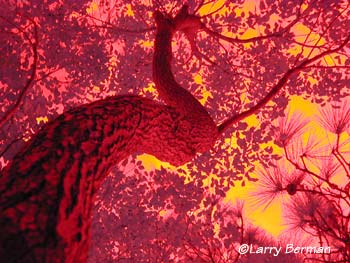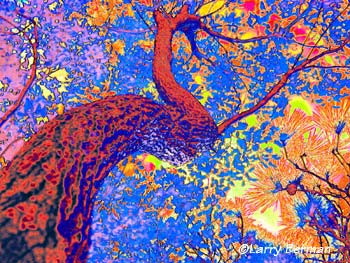|
These are the images and technique
questions appearing in the book |
|
|
|
| Questions and Answers submitted for the book | |
| John Clements: (1) If the image was captured digitally why? What appeals about digital
capture over conventional imaging to you or do you shoot both?
Larry: This is basically a multi part answer. Iíve been shooting exclusively digitally for two years since Nikon came out with the CoolPix 990. Iíve made a living as a fine art photographer for 20+ years, and digital photography has given me a whole new way of creating work. I also take pictures to either illustrate magazine articles or to test digital cameras Iíve been sent to review. In shooting with a review camera, I donít really go into the technical detail as much as I shoot to see if the camera can capture images that work with my artistic vision. The appeal of digital imaging is twofold. First the immediacy of the feedback and the control of the manipulation of the images in an editing program. The second is that properly prepared digital files can be equal to if not higher quality than 35mm film captures. John Clements: (2) How do you work best, by preconceiving what you want, then creating it, or by taking a shot that has latent potential, then seeing where post capture can take things? Larry: My color infrared images are based on light and shadows, just like conventionally photography. What I look for is an interesting architectural abstract or natural scenes where the elements are a combination of infrared reflecting light and natural or man made designs. I never know if the image will work until opening it on the computer and running a few Photoshop actions. I find that Iím carrying the camera wherever I go and constantly shooting and testing. Itís brought excitement back into my photography. John Clements: (3) Can I ask what camera and lens you use for most of your landscape work and specifically for this picture? Larry: Currently Iím using the Nikon CoolPix 950, which has good infrared sensitivity. Though discontinued for almost a year, I was recently able to purchase a second one new on eBay so I could always carry a back up body. At the time I took this image, I hadnít had glass filters made yet so I was using Kodak Wratten gel filters cut to fit the front of the lens on the CoolPix 950 and held in place by the use of the Nikon WC-E63 wide-angle converter. This is the 35mm film camera equivalent of a 24mm wide-angle lens for this picture. Normally I use combinations of two 46mm filters and Nikonís UR-E7 step up adapter so the filters donít vignette as they would if used in 28mm size. Additionally I find that the swivel body design of the CoolPix 900 body series allows you more creative freedom permitting you to experiment with perspectives that are not possible with any other camera. John Clements: (4) Are you Mac or PC based and what is the main manipulation package you use; Photoshop, Paint Shop Pro etc. Larry: Iím PC based and a Photoshop user. I also use ACDSee as an image-viewing program. I find it easy to choose my select images by jumping back and forth from image to image with the mouse wheel. John Clements: (5) Could you provide a "first" exposure so we can show how the image changed after you had finished working on it? Larry: I will provide the original Fine Jpeg that came from the camera. You can see the side by side differences in the two images at the top of the page. John Clements: (6) Ideally, other screen grabs or intermediate stage images would be very useful. Can you help? Larry: I prefer to not give out the exact Photoshop actions I use. What I do stress is that my images are created with combinations of color filters that block visible light. The different colors are a result of the quality of light and shadows hitting the subject. Then I run a series of actions in Photoshop. I learned my technique through experimentation and experience and I stress that interested people do their own experimentation and develop their own techniques and feel that itís best to just give them enough information as a starting point. It wouldnít be a personal vision if everyone was doing it exactly the same way. John Clements: (7) How is this image used by you? Do you make prints for your own enjoyment or exhibition, or is it a big seller in a commercial sense? If the latter to whom has it sold? Larry: I make large prints that are offered for sale at art shows and through corporate art consultants. John Clements: (8) Can you tell me a little of the story behind this shot? When, where and why? Larry: This was one of the first of my color infrared images. In fact, it was taken the first day I started experimenting with the colored filters. John Clements: (9) How much time have you spent post capture on this shot? Larry: I remember spending the entire afternoon experimenting with this particular image and the rest of that shoot from that first day. Because the style was new, I still hadnít worked out my Photoshop steps so this was still an experimental stage for me. John Clements: (10) Can you explain the stages this image went through to enhance it? Larry: See answer 6. John Clements: (11) Can you give us your top three tips for working digitally? Larry: 1 - Always archive the original out of camera files. 2 - Never work on a Jpeg. Always convert it into an uncompressed format before starting so you donít make the mistake of overwriting the original or lessen the quality by the continual saving in a compressed form. 3 - Donít be afraid to experiment. Digital can offer you more creative freedom at less cost than film ever did. John Clements: (12) Do you output onto inkjet, dye sub, art or photo paper? Larry: Iíve been getting 8x10 Fuji Frontier prints and larger sized Lambda and Light Jet prints. The art show market doesnít trust ink jet processes yet. Too many people that arenít concerned with the longevity of their materials are making prints. So I prefer to take that issue out of the equation by getting direct to digital prints on Fuji Crystal Archive paper. John Clements: (13) What do you use material wise for producing your prints? Larry: See answer 12. John Clements: (14) Was this image initially captured as a Jpeg, Tiff or Raw image file? Larry: The original file is a Jpeg shot at full camera resolution of 1600x1200 pixels. John Clements: (15) Any other comments? Larry: I feel that manufacturers should be more open minded in their camera designs. When you purchase a film camera, the only limitation is your artistic vision. For example, if you want to shoot infrared, you put infrared film in the camera and if you want to shoot extreme close ups, you purchase a macro lens or close up filters. Manufacturers should be careful about how many limitations they build into their digital cameras for cost saving reasons as they are limiting the creative possibilities of the people who use their cameras. |
|
|
[ Contents ] |
|


